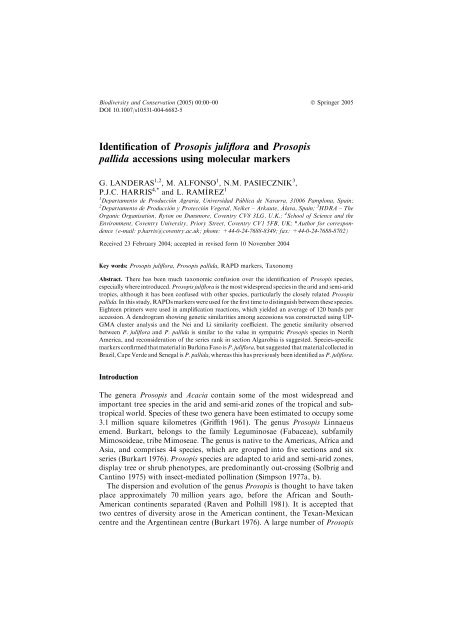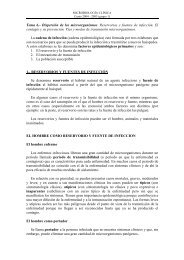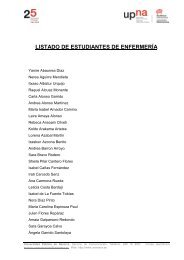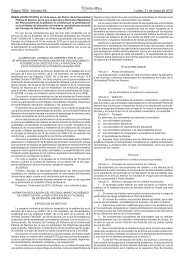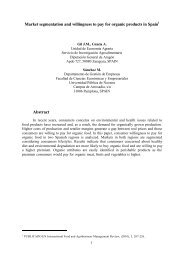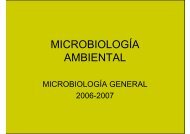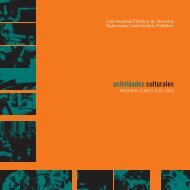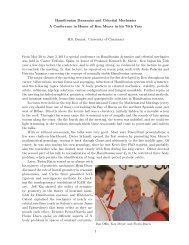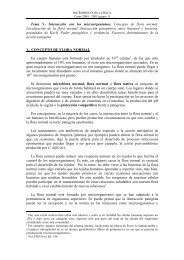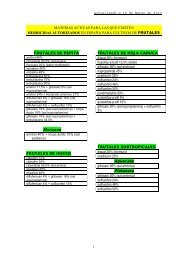Identification of Prosopis juliflora and Prosopis - Universidad Pública ...
Identification of Prosopis juliflora and Prosopis - Universidad Pública ...
Identification of Prosopis juliflora and Prosopis - Universidad Pública ...
You also want an ePaper? Increase the reach of your titles
YUMPU automatically turns print PDFs into web optimized ePapers that Google loves.
2species are sympatric in each centre. Studies using morphological characters(Solbrig et al. 1977), isoenzymes (Saidman 1985), seed protein electrophoresis(Burghardt <strong>and</strong> Palacios 1997) <strong>and</strong> molecular markers (Ramírez et al. 1999)have shown the occurrence <strong>of</strong> intra- as well as inter-series hybrids in populations<strong>of</strong> both sections Algarobia <strong>and</strong> Strombocarpa. These studies, however,support the division <strong>of</strong> the genus into sections. Pasiecznik et al. (2001) havesuggested the grouping <strong>of</strong> species <strong>of</strong> section Algarobia into ‘complexes’ or‘species groups’ principally according to their genetic similarity <strong>and</strong> geographicdistribution, but also to their habit <strong>and</strong> resource characters.<strong>Prosopis</strong> <strong>juliflora</strong> Swartz DC. <strong>and</strong> <strong>Prosopis</strong> pallida (Humbolt & Bonpl<strong>and</strong> exWilld.) H.B.K. were grouped into the ‘P. <strong>juliflora</strong>–pallida complex’ by Pasieczniket al. (2001), a suggestion also made earlier by Felker (1990). These twospecies occur over a broad geographical area approximately limited by thetropics <strong>of</strong> Cancer <strong>and</strong> Capricorn, including Mexico, Guatemala, El Salvador,Honduras, Nicaragua, Costa Rica, Panama, Colombia, Venezuela, Ecuador,Peru <strong>and</strong> the Caribbean isl<strong>and</strong>s. The species <strong>of</strong> section Algarobia to the northare P. gl<strong>and</strong>ulosa Torrey, P. laevigata (Humbolt & Bonpl<strong>and</strong> ex Willd.) M.C.Johnston <strong>and</strong> P. velutina Wooton, which may be considered a North Americancomplex. To the south <strong>of</strong> the P. <strong>juliflora</strong>–pallida complex lie all other species <strong>of</strong>section Algarobia, including P. chilensis (Molina) Stuntz emend. Burkart.The P. <strong>juliflora</strong>–pallida complex was divided into three geographically distinctgroups, termed ‘races’ by Pasiecznik et al. (2001). Group 1 comprisespopulations in Ecuador <strong>and</strong> Peru. P. pallida has been identified throughout thisarea while three varieties <strong>of</strong> P. <strong>juliflora</strong> have been identified in northern Peru<strong>and</strong> southern Ecuador (Burkart 1976). Burkart (1976) also reported a possibleP. <strong>juliflora</strong> · P. pallida hybrid in Ecuador. Populations in the north <strong>of</strong> this areadisplay some phenotypic characteristics typical <strong>of</strong> P. <strong>juliflora</strong> while those in thecentre <strong>and</strong> south appear to be purely P. pallida. Group 2 comprises populations<strong>of</strong> P. <strong>juliflora</strong> in Colombia, Venezuela <strong>and</strong> the Caribbean isl<strong>and</strong>s. Severalauthorities have included the Caribbean in the native range, <strong>and</strong> if not nativethey became naturalised in prehistory (Timyan 1996). Group 3 also comprisespopulations <strong>of</strong> P. <strong>juliflora</strong>, in the Pacific coastal areas <strong>of</strong> Central America fromMexico to Panama, with some inl<strong>and</strong> extensions. In the north <strong>of</strong> this region,populations <strong>of</strong> P. <strong>juliflora</strong> are thought to overlap with P. gl<strong>and</strong>ulosa <strong>and</strong>P. laevigata (Pasiecznik et al. 2001). However, the status <strong>of</strong> P. <strong>juliflora</strong> inMexico is uncertain (Pasiecznik et al. 2001), although recent work usingmolecular markers is beginning to resolve some <strong>of</strong> the underlying geneticvariation found here (Jua´rez-Mun˜ oz et al. 2002).Many <strong>Prosopis</strong> species are valuable multipurpose biotic resources in theirnative range <strong>and</strong> where introduced, providing timber, firewood, livestock feed,human food, shade, shelter <strong>and</strong> soil improvement (Harris et al. 1998). Severalspecies, for example the sub-tropical P. chilensis, P. gl<strong>and</strong>ulosa <strong>and</strong> P. velutina,<strong>and</strong> more importantly, the tropical species, P. <strong>juliflora</strong> <strong>and</strong> P. pallida, have beenintroduced in the last 200 years <strong>and</strong> are now widespread in, for example,Brazil, Sahelian Africa, South Africa, Pakistan, India <strong>and</strong> Australia. However,
paper moistened with sterile distilled water <strong>and</strong> germinated for 8–10 days at20–18 ° C day-night, respectively, 80% relative humidity <strong>and</strong> 12 h photoperiod.Cotyledons were then harvested from seedlings <strong>and</strong> stored individually at80 ° C.5DNA manipulationGenomic DNA was obtained from cotyledons according to the protocol describedby Lassner et al. (1989) with the following modifications: 100 mg <strong>of</strong>plant material (average weight <strong>of</strong> two cotyledons <strong>of</strong> a single plant) were groundin a microcentrifuge tube containing 300 ll <strong>of</strong> extraction buffer (100 mM Tris–HCl, 50 mM EDTA, 500 mM NaCl,10 mM b-mercaptoethanol, pH 8.0).After grinding, 400 ll <strong>of</strong> extraction buffer <strong>and</strong> 400 ll <strong>of</strong> chlor<strong>of</strong>orm/isoamylalcohol (24:1 v/v) were added to the sample, mixed gently <strong>and</strong> incubated for12 min at 60 ° C. After incubation, the two phases were separated by centrifugation(15 min, 14,000 rpm) <strong>and</strong> the supernatant was recovered <strong>and</strong> theDNA precipitated by adding 1.2 volumes <strong>of</strong> cold ( 20 ° C) 2-propanol <strong>and</strong>incubated for 45 min. The genomic DNA was collected by centrifugation at14000 rpm for 15 min. The pellet was rinsed with 70% ethanol-10 mM sodiumacetate, dried <strong>and</strong> resuspended in TE buffer (Tris HCl 10 mM, EDTA 1 mM,pH 7.8). The RNA was removed by treatment with 25 lg ml1 <strong>of</strong> RNAse. Thegenomic DNA was dissolved in sterile water to a final concentration <strong>of</strong> 20 ngll1 . General molecular biology protocols were used as described by Sambrooket al. (1989).In order to generate RAPD markers specific for the species studied, pools <strong>of</strong>DNA containing equal amounts <strong>of</strong> DNA purified from ten samples <strong>of</strong> the samespecies were used as templates. Polymerase chain reactions (PCR) for thegeneration <strong>of</strong> RAPD markers were performed as described by Williams et al.(1990) in a reaction volume <strong>of</strong> 25 ll containing 120 ng <strong>of</strong> pooled DNA astemplate, 2 mM MgCl 2 , 67 mM Tris HCl (pH 8.8), 16 mM (NH 4 )SO 4 ,0.1 g l1 Tween-20, 200 lM each <strong>of</strong> the four nucleotide triphospates (ATP,CTP, GTP, <strong>and</strong> TTP), 0.2 lM <strong>of</strong> the primer oligonucleotide <strong>and</strong> one unit <strong>of</strong>Taq polymerase (Eurobiotaq, Ecogen, Barcelona, Spain). The oligonucleotidesused as primers (20 primers) for the reaction were 10-mers belonging to the L,P, S <strong>and</strong> R Operon series (Operon Technologies Inc. Alameda, California,USA). Amplification reactions were performed in a PTC-200 (Peltier ThermalCycler, MJ Research, Watertown, Massachusetts, USA) using the followingprogramme: 4 min <strong>of</strong> initial denaturation at 94 ° C followed by 40 cycles <strong>of</strong>PCR reaction (1 min denaturation at 94 ° C, 1 min annealing at 37 ° C, 1.3 minextension at 72 ° C). Amplification products were analysed by electrophoresis in1.5% (w/v) agarose gels in TAE buffer (400 mM Tris, 200 mM sodium acetate,20 mM EDTA, pH 8.3) <strong>and</strong> stained with ethidium bromide. U29 HindIII digestedDNA <strong>and</strong> k HindIII-EcoRI were used as molecular size markers. Inthose experiments in which the amplification products were detected by DNA
7presence or absence <strong>of</strong> each marker was scored in each accession <strong>and</strong> Nei’ssimilarity index (Nei <strong>and</strong> Li 1979) was applied to establish similarities. Thesimilarity values were used to cluster species using the unweighted pair groupmethod average (UPGMA) algorithm (Sneath <strong>and</strong> Sokal 1973).ResultsMolecular markers: section-specific, species-specific <strong>and</strong> complex-specificThe molecular markers obtained by PCR amplification that identified speciesbelonging to the section Algarobia, those that differentiated between P. <strong>juliflora</strong><strong>and</strong> P. pallida <strong>and</strong> those that characterised the P. <strong>juliflora</strong>–pallida complexin this study are presented in Table 2. Twenty primers yielded pr<strong>of</strong>iles usefulfor classification <strong>of</strong> the accessions. Six primers: L02 (775) , L06 (800) , L09 (335) ,S03 (550) , S07 (1160) <strong>and</strong> R17 (1220) (Figure 1) produced molecular markers thatwere present in all the accessions analysed except P. cineraria. Thus, five newprimers were added to S07 (1160) , previously described by Ramı´rez et al. (1999)as a section-specific marker for section Algarobia. Assuming that theseamplification products are all derived from <strong>Prosopis</strong> species forming part <strong>of</strong> thesection Algarobia, it could be suggested that there are section-specific molecularmarkers.The markers L04 (325) ; P01 (550) ; P08 (730) ; P09 (570) ; P13 (1250) ; P14 (510) ;S07 (980) <strong>and</strong> S11 (460) were present in P. pallida seeds collected in Trujillo. Asthe amplification products in plant material collected in Piura, where P. <strong>juliflora</strong><strong>and</strong> P. pallida are sympatric, are essentially identical to those present inmaterial from Trujillo, it may be concluded that the sample from Piura isP. pallida or a very closely related hybrid (Figure 2a). Seed from introducedpopulations presently identified as P. <strong>juliflora</strong> from Brazil, Cape Verde <strong>and</strong>Senegal, <strong>and</strong> seed collected in Brazil <strong>and</strong> classified as P. affinis Sprengel allshowed similar molecular pr<strong>of</strong>iles to‘ that amplified in DNA extracted fromseed collected in Trujillo <strong>and</strong> Piura. Thus, all <strong>of</strong> these accessions correspond toTable 2. Molecular markers found in the <strong>Prosopis</strong> samples.SectionP. <strong>juliflora</strong>–pallidaP. pallidaP. <strong>juliflora</strong>Algarobiacomplex markersmarkersmarkersmarkersL02 (775) L01 (520) L04 (325) L04 (410)L06 (800) P01 (550) P08 (440)L09 (335) P08 (730) P12 (760)S03 (550) P09 (570) P12 (610)S07 (1160) P13 (1250) P14 (745)R17 (1220) P14 (510)S07 (980)S11 (460)
8P. pallida <strong>and</strong> do not correspond to any other species likely to occur in thatarea (Pasiecznik et al. 2001). Seeds <strong>of</strong> a putative P. chilensis · P. pallida hybridfrom Cape Verde also displayed an amplification pattern similar to that presentedby P. pallida (Figure 2a). The amplification pr<strong>of</strong>ile corresponding to theputative P. chilensis · P. pallida hybrid showed b<strong>and</strong>s present in P. pallida, <strong>and</strong>some b<strong>and</strong>s present in P. chilensis could also be seen (data not shown). Whilethis confirms P. pallida as one <strong>of</strong> the parents <strong>of</strong> the putative hybrid, P. chilensiswas not specifically analysed in this study <strong>and</strong> thus can only be tentativelyconfirmed as the other parent. When DNA derived from seeds <strong>of</strong> P. <strong>juliflora</strong>collected in Honduras was analysed it could be seen that different loci wereamplified. Five species-specific molecular markers were found: L04 (410) (Figure3), P08 (440) , P012 (760) , P12 (610) <strong>and</strong> P14 (745) . A similar pr<strong>of</strong>ile was obtainedwhen DNA derived from seeds collected in Burkina Faso, presentlyidentified as P. <strong>juliflora</strong>, was amplified. Thus, the plant material collected inBurkina Faso is very likely to be P. <strong>juliflora</strong> <strong>and</strong> differs from P. pallida.When the oligonucleotide L01 was used as primer in amplification reactionsusing as template DNAs derived from plant material collected in Honduras(P. <strong>juliflora</strong>), Piura <strong>and</strong> Trujillo (P. pallida), Senegal, Cape Verde, Brazil,Burkina Faso, in the putative hybrid P. chilensis · P. pallida <strong>and</strong> the materialFigure 2. (a) Amplification <strong>of</strong> the marker S11 460 , specific to P. pallida, using oligonucleotide S11as primer <strong>and</strong> the DNAs purified from all accessions analysed in this paper as templates. (b)Southern hybridisation <strong>of</strong> the cloned marker S11 460 used as probe on membranes containing theamplification products using S11 as oligonucleotide primer <strong>and</strong> the genomic DNA from allaccessions analysed in this paper as templates. Lane names as Figure 1.
9Figure 3. Amplification <strong>of</strong> the marker L04 410 using oligonucleotide L04 as primer <strong>and</strong> the DNAspurified from all accessions analysed in this paper as templates. Note that this oligonucleotideamplifies a low molecular weight marker present in P. pallida accessions. Lane names as Figure 1.classified as P. affinis, it could be seen that a DNA fragment <strong>of</strong> approximately520 bp was present in all the samples (Figure 4a). This result suggests that theL01 (520) marker could be a P. <strong>juliflora</strong>–pallida complex-specific marker. DNAhybridisation experiments (see below) confirm this result (Figure 4b).RAPD markers identityThe identification <strong>of</strong> species on the basis <strong>of</strong> their RAPD pr<strong>of</strong>iles relies on theassumption that b<strong>and</strong>s <strong>of</strong> the same size appearing in different individuals,populations <strong>and</strong>/or species correspond to identical sequences <strong>and</strong> not only to acircumstantial coincidences in size. In order to test this assumption, hybridisationexperiments were performed with cloned RAPD markers.It could be seen that the cloned RAPD marker S11 (460) highlighted a b<strong>and</strong>that was present in plant material collected in Trujillo <strong>and</strong> Piura as well as inthe accessions from Brazil, Cape Verde <strong>and</strong> Senegal (Figure 2b). This markeralso appeared in samples collected in Brazil <strong>and</strong> classified as P. affinis as well asin the putative P. chilensis · P. pallida hybrid collected in Cape Verde. Theseresults strongly suggest that the marker S11 (460) identifies populations <strong>of</strong>P. pallida. The cloned RAPD marker S11 (460) was absent in sample seeds fromHonduras <strong>and</strong> Burkina Faso which confirms that neither sample is P. pallida.DNA hybridisation experiments using the cloned marker L01 (520) as a probeshowed that accessions collected in Peru (Piura <strong>and</strong> Trujillo) <strong>and</strong> the populationcollected in Honduras belong to the P. <strong>juliflora</strong>–pallida complex (Figure4b). The presence <strong>of</strong> this cloned marker in DNA templates derived fromaccessions collected in Brazil <strong>and</strong> Africa indicate that they also belong to theP. <strong>juliflora</strong>–pallida complex. Figure 4b also clearly shows the presence <strong>of</strong>the complex-specific marker L01 (520) in the putative P. chilensis · P. pallidahybrid.
10Figure 4. (a) Amplification <strong>of</strong> the marker L01 520 , specific to the P. <strong>juliflora</strong>–pallida complex, usingoligonucleotide L01 as primer <strong>and</strong> the DNAs purified from all accessions analysed in this paper astemplates. Note the absence <strong>of</strong> this marker in Lv., Vlt., Gl., <strong>and</strong> Ch. (b) Southern hybridisation <strong>of</strong>the cloned marker L01 520 used as probe on membranes containing the amplification products usingL01 as oligonucleotide primer <strong>and</strong> the genomic DNA from all accessions analysed in this paper astemplates. Lane names as Figure 1.Analysis <strong>of</strong> the similarity <strong>and</strong> clustering <strong>of</strong> <strong>Prosopis</strong> speciesThe RAPD pr<strong>of</strong>iles <strong>of</strong> the different <strong>Prosopis</strong> accessions were evaluated todetermine the degree <strong>of</strong> relatedness among them using numerical taxonomytechniques. Molecular markers present in two accessions were considered asshared markers only if they are <strong>of</strong> similar size. The clustering was performedusing 18 primers on seven accessions each from a different species. The number<strong>of</strong> fragments amplified by each oligonucleotide in each sample was speciesspecificbut the average number <strong>of</strong> RAPD markers per sample was 120 (data notshown). The total number <strong>of</strong> b<strong>and</strong>s per sample as well as the number <strong>of</strong> b<strong>and</strong>sshared in each pair-wise comparison (data not shown) allowed the construction<strong>of</strong> a similarity matrix (Table 3) using the Nei <strong>and</strong> Li similarity index. The lowestsimilarity (0.09) resulted from the pair-wise comparison between an Old World<strong>Prosopis</strong> species (P. cineraria, section <strong>Prosopis</strong>) <strong>and</strong> the rest <strong>of</strong> the accessions(section Algarobia), while the highest value (0.73) resulted from both the pairwisecomparisons P. gl<strong>and</strong>ulosa–laevigata <strong>and</strong> P. <strong>juliflora</strong>–pallida.Data from the similarity matrix were used to group the species using theUPGMA method (Figure 5). The cluster analysis revealed two major clusters;
11Table 3.Matrix <strong>of</strong> similarity among the <strong>Prosopis</strong> species studied.P. pallida(Tr)P. <strong>juliflora</strong>(Hnd)P. laevigata P. velutina P. gl<strong>and</strong>ulosa P. chilensis P. cinerariaP. pallida(Trujillo)P. <strong>juliflora</strong> 0.73(Honduras)P. laevigata 0.48 0.51P. velutina 0.47 0.53 0.71P. gl<strong>and</strong>ulosa 0.47 0.55 0.73 0.71P. chilensis 0.42 0.39 0.40 0.41 0.42P. cineraria 0.08 0.09 0.09 0.09 0.09 0.09one formed by P. <strong>juliflora</strong> <strong>and</strong> P. pallida (similarity 0.73), <strong>and</strong> a second comprisingthe North America species, P. laevigata, P. gl<strong>and</strong>ulosa <strong>and</strong> P. velutina(0.71). When the P. <strong>juliflora</strong>–pallida cluster was compared with the NorthAmerica cluster, the similarity value was 0.50. The similarity value betweenP. chilensis <strong>and</strong> the large cluster formed by P. laevigata, P. gl<strong>and</strong>ulosa,P. velutina, P. <strong>juliflora</strong> <strong>and</strong> P. pallida was 0.40. The North American cluster(P. laevigata, P. gl<strong>and</strong>ulosa <strong>and</strong> P. velutina) showed similarity values <strong>of</strong> 0.53<strong>and</strong> 0.47, respectively, when compared with P. <strong>juliflora</strong> (Honduras) <strong>and</strong>P. pallida (Trujillo) (data not shown). When P. chilensis was compared withP. <strong>juliflora</strong> (Honduras) <strong>and</strong> P. pallida (Trujillo) the similarity values were 0.40<strong>and</strong> 0.42, respectively.Figure 5. Dendrogram showing the estimates <strong>of</strong> the percentage <strong>of</strong> similarity among the <strong>Prosopis</strong>species studied. The Nei similarity index (Nei <strong>and</strong> Li 1979) <strong>and</strong> the UPGMA clustering algorithm(Sneath <strong>and</strong> Sokal 1973) were used.
12DiscussionThe value <strong>of</strong> molecular markers in clarifying the taxonomy <strong>of</strong> the genus<strong>Prosopis</strong> has been demonstrated in this study <strong>and</strong> in an earlier work byRamı´rez et al. (1999). Results from RAPDs analysis mostly confirm thoseobtained from flavonoid studies (Solbrig et al. 1977) <strong>and</strong> electrophoresis <strong>of</strong>seed proteins (Burghardt <strong>and</strong> Palacios 1997), which divide <strong>Prosopis</strong> intoidentifiable sections <strong>and</strong> species. Morphological analysis has also generally, butnot always, agreed with these findings (Pasiecznik et al. 2001; Harris et al.2003) <strong>and</strong> most recently, ploidy determination has helped to distinguishP. <strong>juliflora</strong> from other <strong>Prosopis</strong> species. However, the results obtained fromRAPDs analysis need to be treated with caution. The presence <strong>of</strong> a speciesspecificmarker in this study distinguishes the species only from others tested<strong>and</strong> does not guarantee that a similar b<strong>and</strong> may not occur in other, as yetuntested, species. The use <strong>of</strong> bulked DNA from 10 seedlings, in some casesfrom more than one mother tree, allows the possibility that some individualgenotypes <strong>of</strong> a species might lack the specific marker. For example, the speciesspecificmarker for P. pallida in this study occurred in all, <strong>and</strong> only in, samplesthat were also identified as P. pallida on the basis <strong>of</strong> leaf morphology <strong>and</strong>ploidy. This suggests that the molecular marker was effective in identifyingP. pallida among the samples in this study even if there is some risk in applyingthe technique to identify a single P. pallida individual in future.Ramı´rez et al. (1999) analysed <strong>Prosopis</strong> species from Asia, Africa <strong>and</strong> SouthAmerica. The present study aimed to analyse species from North <strong>and</strong> CentralAmerica that were not included in the earlier work, thereby extending thecoverage <strong>of</strong> the native range <strong>of</strong> the genus. Two <strong>of</strong> the species studied,P. chilensis <strong>and</strong> P. cineraria were common to both studies. In the present study,molecular markers were also applied to resolve the long-st<strong>and</strong>ing taxonomicconfusion regarding the identity <strong>of</strong> P. <strong>juliflora</strong> <strong>and</strong> P. pallida, especially whereintroduced. Although molecular studies have been applied to resolve taxonomicissues in the Argentinean centre, there has, until now, been no molecularstudy in the region from Mexico to Peru, where P. <strong>juliflora</strong> <strong>and</strong> P. pallida arefound <strong>and</strong> which is the origin <strong>of</strong> most <strong>of</strong> the material now widespreadthroughout the semi-arid tropics.Ramı´rez et al. (1999) found a molecular marker (S11 (730) ) which could beused to identify New World <strong>Prosopis</strong> species. In addition, markers were foundthat were specific to each <strong>of</strong> the New World sections Monilicarpa, Strombocarpa<strong>and</strong> Algarobia (Ramírez et al. 1999). In the present study, six markerswere found in all species from section Algarobia, which were absent inP. cineraria (section <strong>Prosopis</strong>) <strong>and</strong> it could be suggested that these were specificto section Algarobia. One <strong>of</strong> these (S07 (1160) ) was also found by Ramı´rez et al.(1999). This strongly suggests this marker as genuinely specific to sectionAlgarobia, now observed in 12 species <strong>of</strong> the section (series Ruscifoliae, Pallidae<strong>and</strong> Chilenses), but was absent in P. kuntzei Harms (series Sericanthae)(Ramı´rez et al. 1999).
Pasiecznik et al. (2001) noted similarities between P. <strong>juliflora</strong> <strong>and</strong> P. pallidasufficient to lead them to treat the two species together as the P. <strong>juliflora</strong>–pallida complex, based on their overlapping geographic range, being the onlytruly tropical American <strong>Prosopis</strong> species, <strong>and</strong> having similar morphology <strong>and</strong>resource characters. The marker L01 (520) was found in both P. <strong>juliflora</strong> <strong>and</strong>P. pallida but not in the other species tested, <strong>and</strong> along with the high similarityindex (0.73), this supports the hypothesis <strong>of</strong> Pasiecznik et al. (2001). However,recent work has suggested a clear division <strong>of</strong> these species using ploidy (Harriset al. 2003), although further detailed studies are still required in areas <strong>of</strong> thenative range where both species have been identified in sympatry to fullyconfirm this.Although this paper did not aim to look for molecular markers specific toNorth American species, the data obtained could differentiate them but alsoclearly show a equivalently high similarity value at 0.70 among P. gl<strong>and</strong>ulosa,P. laevigata <strong>and</strong> P. velutina. Jua´rez-Mun˜ oz et al. (2002) used RAPDs to studythe inter- <strong>and</strong> intra-genetic variation between four wild Mexican populations <strong>of</strong>P. gl<strong>and</strong>ulosa, P. laevigata <strong>and</strong> P. <strong>juliflora</strong> <strong>and</strong> found a genetic variation <strong>of</strong>72.48% between them <strong>and</strong> 27.52% within them, <strong>and</strong> postulated that P. <strong>juliflora</strong>gave rise to the other two species. It may be postulated that these NorthAmerican species could be grouped together into a species complex as has beensuggested by Pasiecznik et al. (2001), <strong>and</strong> South American species <strong>of</strong> sectionAlgarobia also show patterns <strong>of</strong> clustering (Ramírez et al. 1999).Several authors have observed that sympatric <strong>Prosopis</strong> species, where noreproductive isolation exists, are able to form stable fertile hybrids (Hunzikeret al. 1975; Simpson 1977a). Hybrids have been identified in North AmericaJohnston 1962; Solbrig et al. 1977) <strong>and</strong> South America (Hunziker et al. 1975,1986; Burkart 1976; Saidman 1985, 1990). Tentative evidence for a P. pallida· P. chilensis hybrid was provided by this study. Burkart (1976) described aputative hybrid between P. <strong>juliflora</strong> <strong>and</strong> P. pallida in northern Ecuador butnoted that it could be a form <strong>of</strong> P. <strong>juliflora</strong> var. horrida (Kunth) Burkart.Johnston (1962) noted that P. inermis H.B.K. (syn. P. <strong>juliflora</strong> var. inermis(H.B.K.) Burkart) may be a synonym <strong>of</strong> P. pallida. Harris et al. (2003) haveidentified a putative hybrid <strong>of</strong> P. <strong>juliflora</strong> <strong>and</strong> P. pallida in Cape Verde based onploidy, but suggest that while hybrids may form they could be sterile.Pasiecznik et al. (2001) also divided the P. <strong>juliflora</strong>–pallida complex intothree geographically distinct groups; (1) Peru <strong>and</strong> Ecuador, (2) Colombia,Venezuela <strong>and</strong> the Caribbean isl<strong>and</strong>s, <strong>and</strong> (3) Pacific coastal Central American.Accessions from groups 1 <strong>and</strong> 3 were analysed in this study <strong>and</strong> found to begenetically distinct. Range-wide analysis is, however, required in order t<strong>of</strong>urther elucidate the genetic relationships within the P. <strong>juliflora</strong>–pallida complex.Burkart (1976) divided section Algarobia into six series. According toBurkart (1976), P. chilensis, P. <strong>juliflora</strong>, P. gl<strong>and</strong>ulosa, P. laevigata <strong>and</strong>P. velutina are all <strong>of</strong> series Chilenses, while P. pallida is in series Pallidae. Thisstudy clearly differentiated P. pallida <strong>and</strong> P. <strong>juliflora</strong> from each other <strong>and</strong> from13
14other <strong>Prosopis</strong> species using their RAPDs pr<strong>of</strong>iles. However, similarity valuesclearly show that P. <strong>juliflora</strong> is more closely related to P. pallida than to any <strong>of</strong>the tested species <strong>of</strong> series Chilenses. Ramı´rez et al. (1999) found the similaritiesbetween species <strong>of</strong> series Ruscifoliae, Pallidae <strong>and</strong> Chilenses were inconsistentwith the classification advanced by Burkart (1976). While Ramı´rez et al.(1999) found that P. kunzei <strong>of</strong> series Sericanthae was distinct <strong>and</strong> no species <strong>of</strong>series Denudantes or Humiles have been analysed, these studies may suggest areconsideration <strong>of</strong> the series rank within section Algarobia.There is considerable confusion as to the identity <strong>of</strong> <strong>Prosopis</strong> species introducedinto Africa, Asia, Australia <strong>and</strong> Northeast Brazil. The distinct pr<strong>of</strong>ilesobserved with P. pallida <strong>and</strong> P. <strong>juliflora</strong> allow for the accurate identification <strong>of</strong>these species. In Burkina Faso, the accession analysed showed strong similaritiesto P. <strong>juliflora</strong> form Honduras. Therefore, it can be confirmed thatP. <strong>juliflora</strong> is present in Burkina Faso. The accession collected in Cape Verdehad also been identified as P. <strong>juliflora</strong> but perfectly matches P. pallida fromPeru <strong>and</strong> is distinct from P. <strong>juliflora</strong>. As this accession is representative <strong>of</strong> thedominant <strong>Prosopis</strong> used in reforestation programmes, it may be suggested thatmost <strong>Prosopis</strong> in Cape Verde has been incorrectly identified <strong>and</strong> is actuallyP. pallida. Similarly, in Senegal, the accession that had been identified asP. <strong>juliflora</strong> matches P. pallida from Peru, thus confirming that P. pallida ispresent in Senegal. The first recorded introduction <strong>of</strong> <strong>Prosopis</strong> into Africa wasin the early 19th century to Richard Toll, Senegal, then a French colony, wherethe accession tested in this study was collected. At this time, P. pallida wasintroduced to Hawaii from Peru via a herbarium in Paris, France (Esbenshade1980), but no records exists as to the origin <strong>of</strong> the Senegalese material. However,while the accession from Richard Toll has been identified as P. pallida,P. <strong>juliflora</strong> has also been identified by Burkart (1976) indicating that bothspecies are present in Senegal.In the north east <strong>of</strong> Brazil, two accessions were analysed, one <strong>of</strong> which hadbeen identified as P. <strong>juliflora</strong> <strong>and</strong> the other as P. affinis. Molecular markerssuggest that both may in fact be P. pallida. It is accepted that <strong>Prosopis</strong> seed wasintroduced into the northeast <strong>of</strong> Brazil in 1947 from Peru by S.C. Harl<strong>and</strong>(Silva 1990). This can now be assumed to have been P. pallida. However,<strong>Prosopis</strong> has been identified in the north east <strong>of</strong> Brazil as long ago as 1879(Bentham 1879 in Burkart 1976) <strong>and</strong> two distinct types <strong>of</strong> <strong>Prosopis</strong> have beennoted in north east Brazil (Silva 1990). Pasiecznik et al. (2001) state that it ispossible that trade between the Caribbean <strong>and</strong> Brazil may have led to theintroduction <strong>of</strong> P. <strong>juliflora</strong> to the north east <strong>of</strong> Brazil in the 1800s <strong>and</strong> this maybe the origin <strong>of</strong> the <strong>Prosopis</strong> noted by Bentham. Later introductions from Perubeginning in the 1940s, however, are clearly P. pallida. While P. pallida is usedfor afforestation <strong>and</strong> is the most common, it cannot be stated that all <strong>Prosopis</strong>in Northeast Brazil is P. pallida. The identification <strong>of</strong> P. affinis in the Northeast<strong>of</strong> Brazil by Lima <strong>and</strong> Silva (1991) was based on the revised taxonomy <strong>of</strong><strong>Prosopis</strong> in northern Peru by Ferreyra (1987). This was the first description <strong>of</strong>P. affinis in Peru, with Ferreyra (1987) distinguishing it primarily on the basis
<strong>of</strong> pod coloration. Burkart (1976) noted P. affinis as native from Uruguay toParaguay. As the P. affinis identified in Brazil is probably P. pallida, it may alsobe assumed that the P. affinis identified in Peru by Ferreyra is also P. pallida,confirming the exclusion <strong>of</strong> this species from the P. <strong>juliflora</strong>–pallida complex byPasiecznik et al. (2001).Molecular markers have proven to be very useful tools in this study indifferentiating populations <strong>of</strong> the genus <strong>Prosopis</strong> at different taxonomic ranks.This study has allowed the identification <strong>and</strong> differentiation <strong>of</strong> the <strong>Prosopis</strong>species tested <strong>and</strong> has resolved the identity <strong>of</strong> introduced populations. This,<strong>and</strong> parallel studies using ploidy <strong>and</strong> leaf morphology (Harris et al. 2003), havehelped to resolve some <strong>of</strong> the outst<strong>and</strong>ing taxonomical problems <strong>and</strong> has aidedin the development <strong>of</strong> a practical field guide for the identification <strong>of</strong> tropical<strong>Prosopis</strong> species, <strong>and</strong> P. <strong>juliflora</strong> <strong>and</strong> P. pallida in particular (Pasiecznik et al.2004) for the benefit <strong>of</strong> foresters, farmers, extensionists, researchers <strong>and</strong>development workers worldwide.15AcknowledgementsThis work was supported by a grant from the Accio´n Integrada, H.B. 1999–0035 <strong>of</strong> the Spanish Ministerio de Educacio´n y Cultura.ReferencesAlban L., Matorel M., Romero J., Grados N., Cruz, G. <strong>and</strong> Felker P. 2002. Cloning <strong>of</strong> elite,multipurpose trees <strong>of</strong> the <strong>Prosopis</strong> <strong>juliflora</strong>/pallida complex in Piura, Peru. Agr<strong>of</strong>orest. Syst. 54:173–182.Burghardt A.D. <strong>and</strong> Palacios R.A. 1997. Electrophoretic characterisation <strong>of</strong> the American sections<strong>of</strong> <strong>Prosopis</strong> L. (Leguminosae: Mimosoideae). Bull. Int. Group Study Mimosoideae 20: 71–83.Burkart A. 1976. A monograph <strong>of</strong> the genus Posopis (Leguminosae subfam. Mimosoideae). (Part 1<strong>and</strong> 2). Catalogue <strong>of</strong> the recognised species <strong>of</strong> <strong>Prosopis</strong>. J. Arnold Arboretum 57: 219–249, 450–525.Church G.M. <strong>and</strong> Gilbert W. 1984. Genomic sequencing. Proc. Natl. Acad. Sci. 81: 1991–1995.Esbenshade H.W. 1980. Kiawe: a tree crop in Hawaii. Int. Tree Crops J. 1: 125–130.Felker P. 1990. <strong>Prosopis</strong> spp. In: Burns R.M. <strong>and</strong> Mosquera M. (eds), Useful Trees <strong>of</strong> TropicalNorth America. North American Forestry Commission Compendium Publication, No.3. USDAForest Service, Washington DC, USA pp. 85–96.Ferreyra R. 1987. Estudio sistémico de los algarrobos de la costa norte del Perú. Dirección deInvestigacio´n Forestal y de Fauna. Min. de Agricultura, Lima, Peru.Griffith A.L. 1961. Acacia <strong>and</strong> <strong>Prosopis</strong> in the Dry Forests <strong>of</strong> the Tropics. FAO, Rome, Italy.Harris P.J.C., Pasiecznik N.M., Bradbury M. <strong>and</strong> Ramírez L. 1998. Problems <strong>and</strong> potential <strong>of</strong><strong>Prosopis</strong>. In: Prendergast H.D.V., Etkin N.L., Harris D.R. <strong>and</strong> Houghton P.J. (eds), Plants forFood <strong>and</strong> Medicine. Royal Botanic Gardens, Kew, UK pp. 277–293.Harris P.J.C., Pasiecznik N.M., Smith S.J., Billington J. <strong>and</strong> Ramírez L. 2003. Differentiation <strong>of</strong><strong>Prosopis</strong> <strong>juliflora</strong> (Sw.) DC. <strong>and</strong> P. pallida (H. & B. ex. Willd.) H.B.K. using foliar characters <strong>and</strong>ploidy. Forest Ecol. Manage. 180: 153–164.Hunziker J.H., Poggio L., Naranjo C.A. <strong>and</strong> Palacios R.A. 1975. Cytogenetics <strong>of</strong> some species <strong>and</strong>natural hybrids in <strong>Prosopis</strong> (Leguminosae). Can. J. Genet. Cytol. 17: 253–262.
16Hunziker J.H., Saidman B.O., Naranjo C.A., Palacios R.A., Poggio L. <strong>and</strong> Burghardt A.D. 1986.Hybridization <strong>and</strong> genetic variation <strong>of</strong> Argentine species <strong>of</strong> <strong>Prosopis</strong>. Forest Ecol. Manage. 16:301–315.Johnston M.C. 1962. The North American mesquites, <strong>Prosopis</strong> Sect Algarobia (Leguminosae).Brittonia 14: 72–90.Juárez-Muñoz J., Carrillo-Castan˜ eda G., Arreguin R. <strong>and</strong> Rubluo A. 2002. Inter- <strong>and</strong> intra-geneticvariation <strong>of</strong> four populations <strong>of</strong> <strong>Prosopis</strong> using rapd-pcr fingerprints. Biodiver. Conserv. 11: 921–930.Lassner M.W., Peterson P. <strong>and</strong> Yoder J.L. 1989. Simultaneous amplification <strong>of</strong> DNA fragments bypolymerase chain reaction in the analysis <strong>of</strong> transgenic plants <strong>and</strong> their progeny. Plant Mol. Biol.Rep. 7: 116–128.Lima P.C.F. <strong>and</strong> Silva M. de A. 1991. Ocorrência sub-espontânea de uma algaroba no nordeste doBrasil. Boletim de Pesquisa Florestal 22/23: 91–95.Nei M. <strong>and</strong> Li W.H. 1979. Mathematical model for studying genetic variation in terms <strong>of</strong>restriction endonucleases. Proc. Natl. Acad. Sci. 76: 5269–5273.Pasiecznik N.M., Harris P.J.C. <strong>and</strong> Smith S.J. 2004. Identifying Tropical <strong>Prosopis</strong> Species: A FieldGuide. HDRA, Coventry, UK 31 pp.Pasiecznik N.M., Felker P., Harris P.J.C., Harsh L.N., Cruz G., Tewari J.C., Cadoret K. <strong>and</strong>Maldonado L.J. 2001. The <strong>Prosopis</strong> <strong>juliflora</strong> – <strong>Prosopis</strong> pallida Complex: A Monograph. HDRA,Coventry, UK 162 pp.Ramírez L., de la Vega A., Razkin N., Luna V. <strong>and</strong> Harris P.J.C. 1999. Analysis <strong>of</strong> the relationshipsbetween species <strong>of</strong> the genus <strong>Prosopis</strong> revealed by the use <strong>of</strong> molecular markers.Agronomie 19: 69–70.Raven P.H. <strong>and</strong> Polhill R.M. 1981. Biography <strong>of</strong> the Leguminosae. In: Polhill R.M. <strong>and</strong> RavenP.H. (eds), Advances in Legume Systematics. Royal Botanic Gardens, Kew, UK pp. 27–34.Saidman B.O. 1985. Estudio de la variación alozímica en el género <strong>Prosopis</strong>. Ph.D. thesis, Facultadde Ciencias Exactas y Naturales. <strong>Universidad</strong> de Buenos Aires, Argentina.Saidman B.O. 1990. Isozyme studies on hybrids swarms <strong>of</strong> <strong>Prosopis</strong> caldenia <strong>and</strong> sympatric species.Silvae Genet. 39: 5–8.Sambrook J., Fritsch E.F. <strong>and</strong> Maniatis T. 1989. Molecular Cloning, A Laboratory Manual. ColdSpring Harbor Laboratory Press, Cold Spring Harbor, USA.Silva S. 1990. <strong>Prosopis</strong> <strong>juliflora</strong> (Sw) DC in Brazil. In: Habit M.A. <strong>and</strong> Saavedra J.C. (eds), TheCurrent State <strong>of</strong> Knowledge on <strong>Prosopis</strong> <strong>juliflora</strong>. FAO, Rome, Italy pp. 29–55.Simpson B.B. 1977a. Breeding systems <strong>of</strong> dominant perennial plants <strong>of</strong> two disjunct warm desertecosystems. Oecologia 27: 203–226.Simpson B.B. 1977b. Mesquite. Its Biology in Two Desert Shrub Ecosystems. Dowden, Hutchinson<strong>and</strong> Ross, Stroudsburg, Pennsylvania, USA.Sneath P.H.A. <strong>and</strong> Sokal R.R. 1973. Numerical Taxonomy. The Principles <strong>and</strong> Practice <strong>of</strong>Numerical Classification. W.H. Freeman <strong>and</strong> Company, San Francisco, USA.Solbrig V. <strong>and</strong> Cantino O.P. 1975. Reproductive adaptations in <strong>Prosopis</strong> (Leguminosae, Mimosoideae).J. Arnold Arboretum 56: 185–210.Solbrig O.T., Bawa K., Carmen N.J., Hunziker J.H., Naranjo C.A., Palacios R.A., Poggio L. <strong>and</strong>Simpson B.B. 1977. Patterns <strong>of</strong> variation. In: Simpson B.B. (ed), Mesquite. Its Biology in TwoDesert Ecosystems. Dowden, Hutchinson <strong>and</strong> Ross, Stroudsburg, Pennsylvania, USA pp. 44–60.Stewart J.L., Dunsdon A.J., Hellin J.J. <strong>and</strong> Hughes C.E. 1992. Wood Biomass Estimation <strong>of</strong>Central American Dry Zone Species. Tropical Forestry Paper 26. Oxford Forestry Institute,Oxford, UK.Timyan J. 1996. Bwa Yo: Important Trees <strong>of</strong> Haiti. South East Consortium for InternationalDevelopment, Washington DC, USA.Williams J.G.K., Kulbelik A.R., Livak K.J., Rafalski J.A. <strong>and</strong> Tingey S.V. 1990. DNA polymorphismsamplified by arbitrary primers are useful as genetics markers. Nucl. Acid Res. 18:6531–6535.


